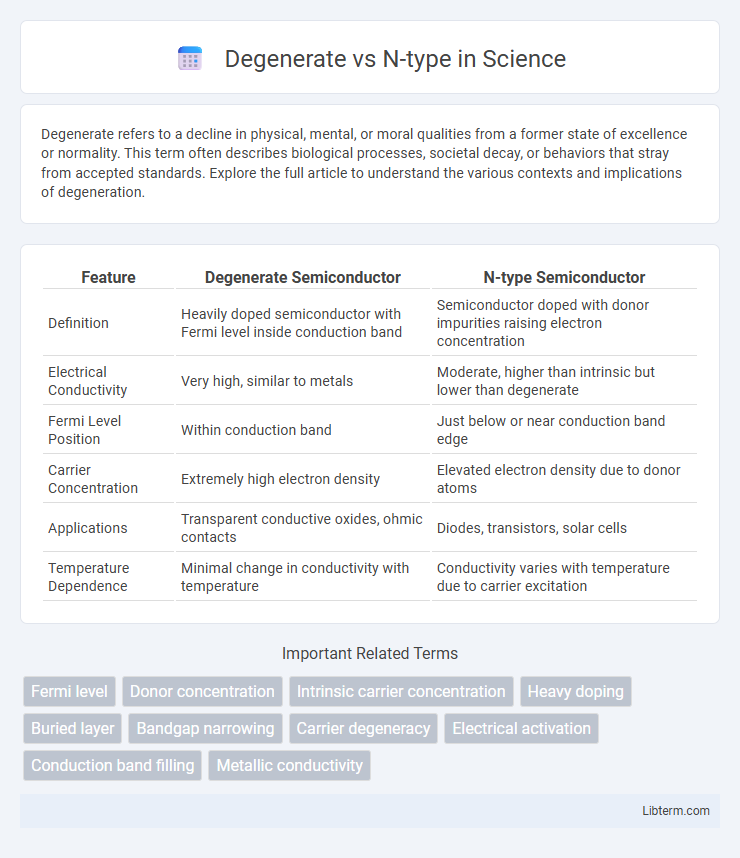Degenerate refers to a decline in physical, mental, or moral qualities from a former state of excellence or normality. This term often describes biological processes, societal decay, or behaviors that stray from accepted standards. Explore the full article to understand the various contexts and implications of degeneration.
Table of Comparison
| Feature | Degenerate Semiconductor | N-type Semiconductor |
|---|---|---|
| Definition | Heavily doped semiconductor with Fermi level inside conduction band | Semiconductor doped with donor impurities raising electron concentration |
| Electrical Conductivity | Very high, similar to metals | Moderate, higher than intrinsic but lower than degenerate |
| Fermi Level Position | Within conduction band | Just below or near conduction band edge |
| Carrier Concentration | Extremely high electron density | Elevated electron density due to donor atoms |
| Applications | Transparent conductive oxides, ohmic contacts | Diodes, transistors, solar cells |
| Temperature Dependence | Minimal change in conductivity with temperature | Conductivity varies with temperature due to carrier excitation |
Introduction to Semiconductor Types
Degenerate semiconductors have a high level of impurity doping that shifts the Fermi level into the conduction band, resulting in metallic-like conductivity. N-type semiconductors are typically doped with donor atoms such as phosphorus or arsenic, which introduce extra electrons and position the Fermi level near the conduction band edge. Understanding the distinction between degenerate and standard n-type semiconductors is crucial for tailoring electrical properties in devices like high-speed transistors and infrared detectors.
Understanding Degenerate Semiconductors
Degenerate semiconductors exhibit extremely high doping levels, causing their Fermi level to shift into the conduction band, unlike typical N-type semiconductors where the Fermi level lies just below the conduction band edge. This results in metallic-like electrical conductivity and altered carrier statistics, making degenerate semiconductors critical in applications such as transparent conducting oxides and advanced optoelectronic devices. Understanding the behavior of degenerate semiconductors is essential for optimizing materials used in high-performance electronic components and sensors.
What Defines N-type Semiconductors?
N-type semiconductors are defined by the introduction of donor impurities, such as phosphorus or arsenic, into an intrinsic semiconductor like silicon, resulting in an excess of free electrons as majority charge carriers. These additional electrons enhance electrical conductivity by increasing carrier concentration without significantly altering the lattice structure. Unlike degenerate semiconductors, N-type materials maintain a non-degenerate Fermi level, meaning the Fermi energy resides within the bandgap, allowing for controlled donor electron excitation.
Key Differences: Degenerate vs N-type
Degenerate semiconductors exhibit extremely high doping levels causing the Fermi level to enter the conduction band, resulting in metallic-like conductivity, whereas N-type semiconductors have moderate donor doping with the Fermi level positioned just below the conduction band, enabling electron conduction through thermally excited carriers. The key difference lies in carrier concentration: degenerate semiconductors possess carrier concentrations on the order of 10^20 cm^-3 or higher, vastly exceeding the typical 10^15 to 10^18 cm^-3 found in N-type materials. This leads to drastically different electrical behaviors, with degenerate semiconductors showing temperature-independent conductivity and N-type semiconductors maintaining temperature-dependent conduction.
Electron Concentration in Degenerate Semiconductors
Degenerate semiconductors exhibit electron concentrations that exceed the effective density of states in the conduction band, causing the Fermi level to lie within or above the conduction band edge. In contrast, N-type semiconductors have electron concentrations significantly lower than degenerate levels, with the Fermi level positioned just below the conduction band. This high electron concentration in degenerate semiconductors leads to metallic-like conductivity and impacts the material's electronic and optical properties.
Doping Levels and Electrical Conductivity
Degenerate semiconductors feature extremely high doping levels, typically above 10^19 cm^-3, causing their Fermi level to lie within the conduction band, resulting in metallic-like electrical conductivity. In contrast, N-type semiconductors have moderate doping concentrations, usually ranging from 10^15 to 10^18 cm^-3, positioning the Fermi level just below the conduction band and enabling semiconductor behavior with enhanced conductivity compared to intrinsic material. The key difference is the transition from semiconductor to metallic conduction, driven by doping concentration and the corresponding shift in electronic band structure.
Fermi Level Position in Degenerate and N-type
In n-type semiconductors, the Fermi level is positioned just below the conduction band, indicating moderate electron concentration and typical doping levels. Degenerate semiconductors exhibit a Fermi level inside or above the conduction band, reflecting extremely high electron concentration and metallic-like conductivity. The shift of the Fermi level into the conduction band in degenerate materials results from heavy doping that causes band filling and significant alteration of electronic properties.
Applications of Degenerate Semiconductors
Degenerate semiconductors, characterized by extremely high doping levels that cause the Fermi level to enter the conduction band, are widely used in applications requiring high electrical conductivity such as transparent conductive oxides in solar cells and display technologies. Unlike typical n-type semiconductors, degenerate materials maintain metallic conductivity while still providing semiconductor properties, making them ideal for thermoelectric devices and advanced sensors. These applications benefit from the combined attributes of low resistivity and optical transparency, which are critical for efficient energy conversion and optoelectronic performance.
Practical Uses of N-type Materials
N-type materials, characterized by electrons as the majority charge carriers, are extensively used in semiconductor technology for applications such as transistors, diodes, and integrated circuits. These materials enable efficient electron flow, enhancing device performance in electronics and photovoltaic cells. In contrast to degenerate semiconductors, N-type materials offer controlled conductivity crucial for creating p-n junctions and achieving desired electrical properties in practical electronic devices.
Summary: Choosing Between Degenerate and N-type
Selecting between degenerate and N-type semiconductors depends on desired electrical properties and application requirements. Degenerate semiconductors exhibit high doping levels, resulting in metallic-like conductivity, making them ideal for applications such as transparent conductors and highly efficient electronic devices. N-type semiconductors, with moderate doping and excess electrons as majority carriers, offer controlled conductivity suitable for standard electronic components like diodes and transistors.
Degenerate Infographic

 libterm.com
libterm.com